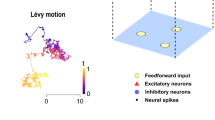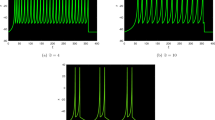Abstract
Neural systems adapt to changes in stimulus statistics. However, it is not known how stimuli with complex temporal dynamics drive the dynamics of adaptation and the resulting firing rate. For single neurons, it has often been assumed that adaptation has a single time scale. We found that single rat neocortical pyramidal neurons adapt with a time scale that depends on the time scale of changes in stimulus statistics. This multiple time scale adaptation is consistent with fractional order differentiation, such that the neuron's firing rate is a fractional derivative of slowly varying stimulus parameters. Biophysically, even though neuronal fractional differentiation effectively yields adaptation with many time scales, we found that its implementation required only a few properly balanced known adaptive mechanisms. Fractional differentiation provides single neurons with a fundamental and general computation that can contribute to efficient information processing, stimulus anticipation and frequency-independent phase shifts of oscillatory neuronal firing.
This is a preview of subscription content, access via your institution
Access options
Subscribe to this journal
Receive 12 print issues and online access
$209.00 per year
only $17.42 per issue
Buy this article
- Purchase on Springer Link
- Instant access to full article PDF
Prices may be subject to local taxes which are calculated during checkout







Similar content being viewed by others
References
Adrian, E.D. & Zotterman, Y. The impulses produced by sensory nerve endings: part 2. The response of a single end-organ. J. Physiol. (Lond.) 61, 151–171 (1926).
Barlow, H.B. Possible principles underlying the transformation of sensory messages. in Sensory Communication (ed. Rosenblith, W.) 217–234 (MIT Press, Cambridge, Massachusetts, 1961).
Brenner, N., Bialek, W. & de Ruyter van Steveninck, R. Adaptive rescaling maximizes information transmission. Neuron 26, 695–702 (2000).
Fairhall, A.L., Lewen, G.D. & Bialek, W. de Ruyter Van Steveninck, R.R. Efficiency and ambiguity in an adaptive neural code. Nature 412, 787–792 (2001).
Dean, I., Harper, N.S. & McAlpine, D. Neural population coding of sound level adapts to stimulus statistics. Nat. Neurosci. 8, 1684–1689 (2005).
Diaz-Quesada, M. & Maravall, M. Intrinsic mechanisms for adaptive gain rescaling in barrel cortex. J. Neurosci. 28, 696–710 (2008).
Higgs, M.H., Slee, S.J. & Spain, W.J. Diversity of gain modulation by noise in neocortical neurons: regulation by the slow after-hyperpolarization conductance. J. Neurosci. 26, 8787–8799 (2006).
Kim, K.J. & Rieke, F. Temporal contrast adaptation in the input and output signals of salamander retinal ganglion cells. J. Neurosci. 21, 287–299 (2001).
Maravall, M., Petersen, R.S., Fairhall, A.L., Arabzadeh, E. & Diamond, M.E. Shifts in coding properties and maintenance of information transmission during adaptation in barrel cortex. PLoS Biol. 5, e19 (2007).
Nagel, K.I. & Doupe, A.J. Temporal processing and adaptation in the songbird auditory forebrain. Neuron 51, 845–859 (2006).
Sanchez-Vives, M.V., Nowak, L.G. & McCormick, D.A. Cellular mechanisms of long-lasting adaptation in visual cortical neurons in vitro. J. Neurosci. 20, 4286–4299 (2000).
Smirnakis, S.M., Berry, M.J., Warland, D.K., Bialek, W. & Meister, M. Adaptation of retinal processing to image contrast and spatial scale. Nature 386, 69–73 (1997).
Kvale, M.N. & Schreiner, C.E. Short-term adaptation of auditory receptive fields to dynamic stimuli. J. Neurophysiol. 91, 604–612 (2004).
Hosoya, T., Baccus, S.A. & Meister, M. Dynamic predictive coding by the retina. Nature 436, 71–77 (2005).
Toib, A., Lyakhov, V. & Marom, S. Interaction between duration of activity and time course of recovery from slow inactivation in mammalian brain Na+ channels. J. Neurosci. 18, 1893–1903 (1998).
Schwindt, P.C., Spain, W.J. & Crill, W.E. Long-lasting reduction of excitability by a sodium-dependent potassium current in cat neocortical neurons. J. Neurophysiol. 61, 233–244 (1989).
Abel, H.J., Lee, J.C., Callaway, J.C. & Foehring, R.C. Relationships between intracellular calcium and after-hyperpolarizations in neocortical pyramidal neurons. J. Neurophysiol. 91, 324–335 (2004).
Fleidervish, I.A., Friedman, A. & Gutnick, M.J. Slow inactivation of Na+ current and slow cumulative spike adaptation in mouse and guinea-pig neocortical neurones in slices. J. Physiol. (Lond.) 493, 83–97 (1996).
La Camera, G. et al. Multiple time scales of temporal response in pyramidal and fast-spiking cortical neurons. J. Neurophysiol. 96, 3448–3464 (2006).
Schwindt, P.C., Spain, W.J., Foehring, R.C., Chubb, M.C. & Crill, W.E. Slow conductances in neurons from cat sensorimotor cortex in vitro and their role in slow excitability changes. J. Neurophysiol. 59, 450–467 (1988).
Destexhe, A., Rudolph, M., Fellous, J.M. & Sejnowski, T.J. Fluctuating synaptic conductances recreate in vivo–like activity in neocortical neurons. Neuroscience 107, 13–24 (2001).
Richardson, M.J. Effects of synaptic conductance on the voltage distribution and firing rate of spiking neurons. Phys. Rev. E 69, 051918 (2004).
Crochet, S. & Petersen, C.C. Correlating whisker behavior with membrane potential in barrel cortex of awake mice. Nat. Neurosci. 9, 608–610 (2006).
Hasenstaub, A., Sachdev, R.N. & McCormick, D.A. State changes rapidly modulate cortical neuronal responsiveness. J. Neurosci. 27, 9607–9622 (2007).
Thorson, J. & Biederman-Thorson, M. Distributed relaxation processes in sensory adaptation. Science 183, 161–172 (1974).
French, A.S. & Torkkeli, P.H. The power law of sensory adaptation: simulation by a model of excitability in spider mechanoreceptor neurons. Ann. Biomed. Eng. 36, 153–161 (2008).
Kleinz, M. & Osler, T.J.A. A child's garden of fractional derivatives. Coll. Math. J. 31, 82–88 (2000).
Fourcaud-Trocme, N., Hansel, D., van Vreeswijk, C. & Brunel, N. How spike generation mechanisms determine the neuronal response to fluctuating inputs. J. Neurosci. 23, 11628–11640 (2003).
Kondgen, H. et al. The dynamical response properties of neuocortical neurons to temporally modulated noisy inputs in vitro. Cereb. Cortex 18, 2086–2097 (2008).
Anastasio, T.J. Nonuniformity in the linear network model of the oculomotor integrator produces approximately fractional-order dynamics and more realistic neuron behavior. Biol. Cybern. 79, 377–391 (1998).
Gilboa, G., Chen, R. & Brenner, N. History-dependent multiple time-scale dynamics in a single-neuron model. J. Neurosci. 25, 6479–6489 (2005).
Drew, P.J. & Abbott, L.F. Models and properties of power-law adaptation in neural systems. J. Neurophysiol. 96, 826–833 (2006).
Powers, R.K., Sawczuk, A., Musick, J.R. & Binder, M.D. Multiple mechanisms of spike-frequency adaptation in motoneurones. J. Physiol. (Paris) 93, 101–114 (1999).
Benda, J. & Herz, A.V. A universal model for spike-frequency adaptation. Neural Comput. 15, 2523–2564 (2003).
Mainen, Z.F. & Sejnowski, T.J. Reliability of spike timing in neocortical neurons. Science 268, 1503–1506 (1995).
Middleton, J.W., Longtin, A., Benda, J. & Maler, L. The cellular basis for parallel neural transmission of a high-frequency stimulus and its low-frequency envelope. Proc. Natl. Acad. Sci. USA 103, 14596–14601 (2006).
Lundstrom, B.N. & Fairhall, A.L. Decoding stimulus variance from a distributional neural code of interspike intervals. J. Neurosci. 26, 9030–9037 (2006).
Jolivet, R., Rauch, A., Luscher, H.R. & Gerstner, W. Predicting spike timing of neocortical pyramidal neurons by simple threshold models. J. Comput. Neurosci. 21, 35–49 (2006).
Slee, S.J., Higgs, M.H., Fairhall, A.L. & Spain, W.J. Two-dimensional time coding in the auditory brainstem. J. Neurosci. 25, 9978–9988 (2005).
Fusi, S., Drew, P.J. & Abbott, L.F. Cascade models of synaptically stored memories. Neuron 45, 599–611 (2005).
Paulin, M.G., Hoffman, L.F. & Assad, C. Dynamics and the single spike. IEEE Trans. Neural Netw. 15, 987–994 (2004).
Anastasio, T.J. The fractional-order dynamics of brainstem vestibulo-oculomotor neurons. Biol. Cybern. 72, 69–79 (1994).
Fairhall, A.L., Lewen, G.D., Bialek, W. & de Ruyter van Steveninck, R. in Advances in Neural Information Processing Systems 13 (eds. Leen, T.K., Dietterich, T.G. & Tresp, V.) 124–130 (MIT Press, Cambridge, Massachusetts, 2001).
Puccini, G.D., Sanchez-Vives, M.V. & Compte, A. Integrated mechanisms of anticipation and rate-of-change computations in cortical circuits. PLoS Comput. Biol. 3, e82 (2007).
Wark, B., Lundstrom, B.N. & Fairhall, A. Sensory adaptation. Curr. Opin. Neurobiol. 17, 423–429 (2007).
Wang, X.J., Liu, Y., Sanchez-Vives, M.V. & McCormick, D.A. Adaptation and temporal decorrelation by single neurons in the primary visual cortex. J. Neurophysiol. 89, 3279–3293 (2003).
Ruderman, D.L. & Bialek, W. Statistics of natural images: scaling in the woods. Phys. Rev. Lett. 73, 814–817 (1994).
Simoncelli, E.P. & Olshausen, B.A. Natural image statistics and neural representation. Annu. Rev. Neurosci. 24, 1193–1216 (2001).
Buzsaki, G. & Draguhn, A. Neuronal oscillations in cortical networks. Science 304, 1926–1929 (2004).
Hodgkin, A.L. & Huxley, A.F. A quantitative description of membrane current and its application to conduction and excitation in nerve. J. Physiol. (Lond.) 117, 500–544 (1952).
Acknowledgements
We are grateful to B. Aguera y Arcas, W. Bialek, F. Dunn, M. Famulare, M. Giugliano, S. Hong, M. Maravall, P. Murphy, F. Rieke, L. Sorensen and B. Wark for helpful discussions and/or comments on the manuscript. We thank S. Usher for excellent technical assistance. This work was supported by a Burroughs-Wellcome Careers at the Scientific Interface grant, and a McKnight Scholar Award and a Sloan Research Fellowship to A.L.F. B.N.L. was supported by grant number F30NS055650 from the National Institute of Neurological Disorders and Stroke, the University of Washington's Medical Scientist Training Program (supported by the National Institute of General Medical Sciences), and an Achievement Rewards for College Scientists (ARCS) fellowship. M.H.H. and W.J.S. were supported by a Veterans Affairs Merit Review to W.J.S.
Author information
Authors and Affiliations
Contributions
All authors conceived of and designed the experiments. B.N.L. and M.H.H. performed the experiments. B.N.L. analyzed the data, performed the modeling and wrote the initial draft. All authors revised the paper.
Corresponding author
Supplementary information
Supplementary Text and Figures
Supplementary Figures 1–6, Supplementary Data and Discussion, Supplementary Equations and Supplementary Methods (PDF 678 kb)
Rights and permissions
About this article
Cite this article
Lundstrom, B., Higgs, M., Spain, W. et al. Fractional differentiation by neocortical pyramidal neurons. Nat Neurosci 11, 1335–1342 (2008). https://doi.org/10.1038/nn.2212
Received:
Accepted:
Published:
Issue Date:
DOI: https://doi.org/10.1038/nn.2212
This article is cited by
-
Fractional order memcapacitive neuromorphic elements reproduce and predict neuronal function
Scientific Reports (2024)
-
Dynamics and synchronization control of fractional conformable neuron system
Cognitive Neurodynamics (2024)
-
Effects of high-order interactions on synchronization of a fractional-order neural system
Cognitive Neurodynamics (2024)
-
Diverse electrical responses in a network of fractional-order conductance-based excitable Morris-Lecar systems
Scientific Reports (2023)
-
A biophysical perspective on the resilience of neuronal excitability across timescales
Nature Reviews Neuroscience (2023)



